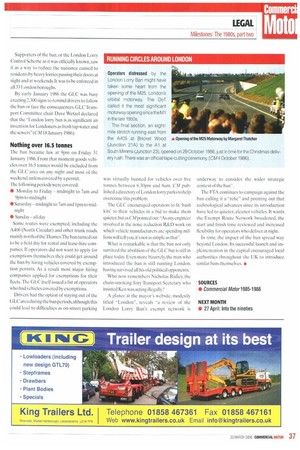[Ando
Page 36

Page 37

If you've noticed an error in this article please click here to report it so we can fix it.
ca in
The London Lorry Ban, new EEC drivers' hours regulations and an orbital motorway for the capital... Patric Cunnane concludes his two-part review of legislation in the eighties
he 1980s threw up colourful political char acters—few more so than Ken Livin.gstone.
His Greater London Council spent a good deal of 1985 doing battle with Margaret Thatcher's government to force through Ken's proposal for a London lorry ban ahead of the GLC's own abolition on I April 1986.
The FTA and the RHA condemned the ban as a -costly and ridiculous restriction which will bring no benefit to Londoners" (CM 18 January 1986). Both supported the Department of Transport's attempts to have the ban declared illegal. September 1985 brought a last-ditch attempt by the DoT to torpedo the ban in a High Court appeal.A "brilliant" OC. said lobe the "most expensive you can get" was called in by the Department ofTransport to mastermind its appeal against the lorry ban ruling (CM yearly round-up,21 December 1985). Supporters of the ban, or the London Lorry Control Scheme as it was officially known, saw it as a way to reduce the nuisance caused to residents by heavy lorries passing their doors at night and at weekends. It was to be enforced in all 33 London boroughs.
By early January 1986 the GLC was busy erecting 2,300 signs to remind drivers to follow the ban or face the consequences. GLC Transport Committee chair Dave Wetzel declared that the "London lorry ban is as significant an invention for Londoners as fresh tap water and the sewers" ( CM 18 January 1986).
Nothing over 16.5 tonnes The ban became law at 9pm on Friday 31 January 1986. From that moment goods vehicles over 16.5 tonnes would be excluded from the GLC area on any night and most of the weekend, unless covered by a permit.
'11-ie following periods were covered: • Monday to Friday — midnight to 7am and 9pm to midnight • Saturdav— midnight to 7am and lpm to midnight • Sunday—all day Some routes were exempted, including the A406 (North Circular) and other trunk roads, mainly north of theThames.The ban turned out to be a field day for rental and lease-hire companies. If operators did not want to apply for exemptions themselves they could get around the ban by hiring vehicles covered by exemption permits. As a result most major hiring companies applied for exemptions for their fleets. The G LC itself issued a list of operators who had vehicles covered by exemptions.
Drivers had the option of staying out of the GLC area during the ban periods, although this could lead to difficulties as on-street parking Operators distressed by the London Lorry Ban might have taken some heart from the opening of the M25, London's orbital motorway. The DoT called it the most significant motorway opening since the M1 in the late 1950s.
The final section, an eightmile stretch running east from the A405 at Bricket Wood (Junction 21A) to the Al at South Mimms (Junction 23), opened on 29 October 1986, just in time for the Christmas delivery rush. There was an official tape-cutting ceremony. (CM4 October 1986).
A Opening of the M25 Motorway by Margaret Thatcher was virtually banned for vehicles over five tonnes between 6.30pm and Sam. CM published a directory of London lorry parks to help overcome this problem.
The GLC encouraged operators to fit 'hush kits' to their vehicles in a bid to make them quieter,but as CM pointed out: "As any engineer involved in the noise reduction R&D work on which vehicle manufacturers are spending millions will tell you, it's not as simple as that".
What is remarkable is that the ban not only survived the abolition of the G LC but is still in place today. Even more bizarrely, the man who introduced the ban is still running London, having survived all his old political opponents.
Who now remembers Nicholas Ridley, the chain-smoking Tory Transport Secretary who insisted Ken was acting illegally?
A glance at the mayor's website, modestly titled "London", reveals "a review of the London Lorry Ban's exempt network is underway to consider the wider strategic context of the ban-.
The ETA continues to campaign against the ban calling it a "relic" and pointing out that technological advances since its introduction have led to quieter, cleaner vehicles. It wants the Exempt Route Network broadened, the start and finish time reviewed and increased flexibility for operators who deliver at night.
In time, the impact of the ban spread way beyond London. Its successful launch and implementation in the capital encouraged local authorities throughout the UK to introduce similar bans themselves. •




































































































































































































